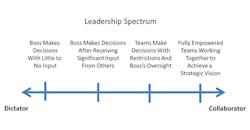This is the first of three articles that will explore a new way of thinking about leadership. This first article will take a look at some of the differences between managing and leading. The second will cover the pros and cons of each of the fence posts on what I like to call the ‘Leadership Spectrum,’ and the third article will highlight other aspects of leadership needed to promote a successful improvement initiative.
What is Leadership? In Dr. W. Edwards Deming’s book “Out of the Crisis,” he shares 14 points on how to transform the culture of an organization to help support process excellence initiatives. One of these points states: “Eliminate management by objective. Eliminate management by numbers, numerical goals. Substitute leadership.”
As I pointed out in my 2013 IndustryWeek article “Does Management by Objectives Stifle Excellence?” when I first presented Dr. Deming’s 14 points to a group of executives in 1991, this point was by far the most controversial and seriously loathed by the audience. Management By Objective (MBO) was (and in most companies still is) a significant part of the way bosses managed (and tried to control) their employees. Dr. Deming was saying with this point that the old ways of management needed to be abolished and a new focus on leadership needed to take its place. This was a lesson he taught to Japanese executives in the mid-20th century… and they listened.
Most people in my training classes were too young to remember what life was like in the 1970s. So I usually begin with a short history lesson about the progress manufacturing has made in the past 50 years. In those early days, U.S. manufacturers could produce a great amount of product, but the quality was erratic. For example, it was common to hear stories of people buying new U.S.-made cars that, after they drove them home, would cover their driveways in leaked oil after only a few days of ownership. In fact, this happened so often that “lemon laws” had to be created to protect the consumer.
Then, seemingly out of nowhere, the U.S. market was flooded with superior Japanese products from companies like Toyota, Honda, Sony and Toshiba. In 1980, NBC ran a special report titled “If Japan Can, Why Can’t We?” This began the “Quality Revolution” using the tools and methodologies of Total Quality Management, lean and Six Sigma. However, there was great resistance by U.S. company executives to changing their management styles. They had grown up with and felt comfortable running their organizations using management tools that had been passed down to them by their bosses (and their boss’s bosses). Management by objectives was (and still is) a deeply engrained way of life.
So, how does a company shift from management to leadership? One of the first steps is to understand the destructive nature of MBO and why that needs to be substituted with leadership. To illustrate this point, I like to use the example of how silly MBO might look like in a family environment:
The twins, Billy and Johnny, had just finished celebrating their 14th birthday when they were summoned by their parents to join them at the kitchen table for their annual “Goals and Objectives” meeting.
“Your father and I spent a great deal of time putting together this year’s goals for you two,” their mother said as they all sat down. “We expect you to meet or exceed these goals over the next 12 months and as you know, next year’s allowance amount will depend on how well you meet these objectives.”
“Let’s start with your goals, Billy,” said their father. “We expect great things from you this next year, so we defined these three objectives. First, we expect a grade average of no less than an A-. Second, we anticipate that not only will you make one of your school’s sports teams, but we have also set a stretch goal of being the team captain. And finally, we expect you to work enough hours this summer mowing peoples’ yards and babysitting that you contribute at least $500 to your college fund.” Billy’s bewildered look on his face clearly indicated that he had no idea on how to meet these goals.
“For you Johnny, we have somewhat lower expectations,” said their mother. “We will be happy as long as you maintain a D+ average, watch less than six hours of TV each day, and only buy three video games a month.”
“Wait a minute!” exclaimed Billy. “These goals aren’t fair! Johnny and I are almost identical in every way. Why is he getting the easy way out?”
“Look, we are the parents and what we say goes,” said their father. “Someday, you will get to call the shots when you become a parent… but not today. We know what’s best for both of you. Now, we need you to sign these documents so we can put them into your personnel files and 12 months from now, during your annual performance review, we will measure your successes and failures… and there had better not be too many failures or there will be consequences!”
“Are there any questions?” said their mother as she and her husband stood up from the kitchen table indicating that the meeting was over. “Ok… We have our own lives to lead. Good luck in hitting your objectives and we will see how you did a year from now.”
This illustration highlights many of the negatives associated with trying to manage employees through setting a series of goals and objectives (vs. providing leadership):
First, many goals seem rather arbitrary in nature and are looked at by most as a form of motivation through fear (you better meet the goal or else). Also, most employees will figure out how their personal objectives match up with others in their peer group and will wonder why their goals are so much more difficult.
Second, most improvement experts have learned over the years that it is important to focus on the process instead of pointing fingers at the employees (this is the main point of Dr. Deming’s Red Bead Experiment). However, MBO usually focuses on what the boss expects the employee to accomplish. If the process the employee utilizes is broken or poorly designed, then they will have a difficult time meeting their objectives no matter how hard they try (red beads), which will lead to a lowering of morale or, worse, the hiding of problems and manipulation of the data to hit the goal.
Third, when goals are set too low (like Johnny’s above), the employees have no incentive to improve the process in order to achieve greatness and can become bored and complacent. On the other hand, if goals are set too high, a sense of hopelessness may overwhelm the employees, which can hamper improvement efforts. In both cases, there are few opportunities to develop a sense of pride and ownership as frustration drives a lowering of morale.
Just so there is no misunderstandings, Dr. Deming did discuss the importance of collecting and analyzing data (he was a professor of statistics after all). However, the data needs to focus on the performance and ‘rate of improvement’ of the entire organization and various processes. These metrics can be displayed on a ‘dashboard’ and posted throughout the organization so the employees can see, real time in some cases, how their improvement efforts are impacting their process and business’s performance. The entire organization can celebrate when they achieve real, sustainable improvement and the data hits new milestones (we will look at how leaders develop people and recognize individual as well as team accomplishments in part 3 of this series).
So, if, according to Dr. Deming, MBO needs to be replaced with leadership, what exactly is leadership? In my next article, we will explore what I like to call the “Leadership Spectrum.”We will look at the pros and cons of each of the four fence posts listed above on the spectrum from dictator to collaborator. Which side of the spectrum do managers reside vs. leaders? The answer I have developed over the years may surprise you. Stay tuned.
Read Part 2: Where is Your Organization on the Leadership Spectrum?
John Dyer is president of the JD&A – Process Innovation Co. and has 28 years of experience in the field of improving processes. He started his career with General Electric and then worked for Ingersoll-Rand before starting his own consulting company. Dyer can be reached at (704) 658-0049 and [email protected]. And find his profile on Linked In.
About the Author

John Dyer
President, JD&A – Process Innovation Co.
John Dyer is president of JD&A – Process Innovation Co. and has 32 years of experience in the field of improving processes. He started his career with General Electric and then worked for Ingersoll-Rand before starting his own consulting company.
John is the author of The Façade of Excellence: Defining a New Normal of Leadership, published by Productivity Press. He is a frequent speaker on topics of leadership, continuous improvement, teamwork and culture change, both within and outside the manufacturing industry.
John is a contributing editor for IndustryWeek, and frequently helps judge the annual IndustryWeek Best Plants Awards competition. He also has presented sessions at the annual IW conference.
John has an electrical engineering degree from Tennessee Tech University, as well as an international master's of business from Purdue University and the University of Rouen in France.
He can be reached by telephone at (704) 658-0049 and by email at [email protected]. View his LinkedIn profile here.

